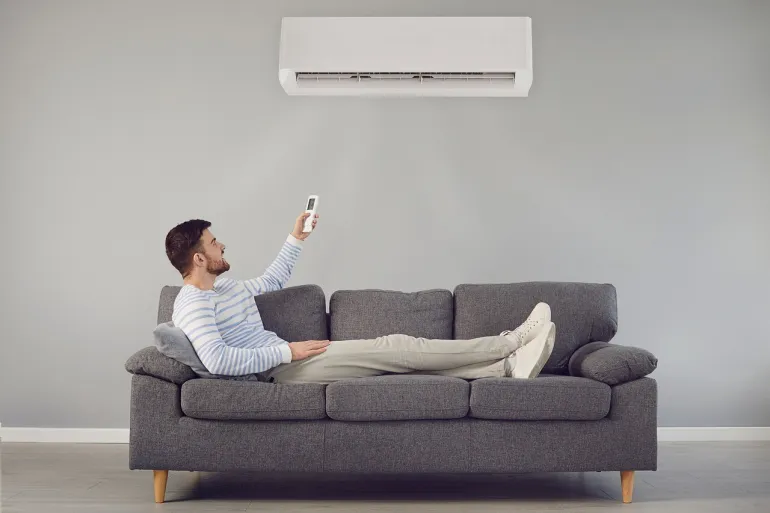Myth 1: Chilled Water Systems are Only Suitable for Large Buildings
The idea that chilled water air conditioning systems are only suitable for massive buildings like office buildings, malls, or factories is a common misconception. The ability of chilled water systems to efficiently cool huge rooms makes them ideal for large buildings, but they can also be used for smaller commercial premises and even homes.
Different cooling needs can be met by utilizing chilled water systems, which are available in a range of sizes and configurations. For example, mini-chilled water systems are ideal for smaller spaces and may be set up in homes, shops, or restaurants. Contrary to popular belief, chilled water systems are not limited to huge buildings. These smaller systems provide the same level of efficiency and comfort as their larger equivalents.
Myth 2: Chilled Water Systems are Complex and Difficult to Maintain
Another common misunderstanding is that chilled water AC systems are too complicated and need too much maintenance to be suitable for most people. Although there are more moving parts in chilled water systems compared to older direct expansion (DX) systems, newer models make them easier to use and keep up with.
Inspecting pumps and valves, making sure pipelines are adequately insulated, and evaluating and modifying water flow rates are common routine maintenance chores for chilled water systems. Qualified technicians can easily complete these activities during their regularly scheduled service visits. In addition, many chilled water systems have the ability to remotely monitor and diagnose problems, which allows for quick troubleshooting and preventative maintenance.
Myth 3: Chilled Water Systems are Less Energy Efficient Than DX Systems
It is often believed that DX systems, which directly cool air with refrigerant, are naturally more energy efficient than chilled water systems. Chilled water systems provide clear benefits in terms of overall energy performance and sustainability, even while DX systems could have greater efficiency ratings under specific conditions. Centralized cooling production and distribution across a building via water-cooled coils and air handling units is made possible by chilled water systems, which function on the principle of water chilling.
The use of energy-saving technologies like free cooling systems and variable speed drives may be more easily integrated with this centralized approach, which also allows for better control over cooling loads. Heat exchangers and other energy recovery components can be added to chilled water systems to collect and repurpose waste heat for heating or other uses. Reduced operating costs and substantial energy savings are possible with well-planned and regularly serviced chilled water systems.
Myth 4: Chilled Water Systems Cause Indoor Air Quality Issues
A prevalent misconception about chilled water HVAC systems is that they worsen indoor air quality (IAQ) by encouraging the growth of microorganisms in the pipes and coils that carry the water. While it’s true that poorly maintained HVAC systems can contain contaminants of any kind, chilled water systems aren’t necessarily more prone to indoor air quality problems than other kinds of HVAC systems. Any building’s indoor air quality (IAQ) can be improved with the right planning, installation, and upkeep of HVAC systems.
The components that contain cold water, like coils and drip pans, must be cleaned and disinfected on a regular basis. Proper ventilation and filtration must be in place to eliminate airborne particles and allergens. In addition, cutting-edge technologies in chilled water systems, like enhanced filtration choices and ultraviolet (UV) germicidal irradiation, can further reduce the likelihood of microbial development and enhance the quality of indoor air. Indoor air quality (IAQ) assessments and best practices for chilled water systems work together to make buildings healthier and more pleasant places to live.
Myth 5: Chilled Water Systems Require Excessive Water Usage
Some individuals are worried about the environmental effect and water waste caused by chilled water air conditioning systems because of the amount of water they use. Although chilled water systems do use water for cooling, the quantity of water used is far less than that of other processes that use a lot of water.
A closed-loop system, in which water is cycled within the system rather than continuously replenished or discharged, is what makes chilled water systems work. Minimizing water losses can be achieved through appropriate system design, regular inspections, and rapid repairs. Evaporation and small leaks are the main causes of water loss. Furthermore, in order to lessen the overall water consumption and lessen the environmental effect, numerous chilled water systems include water-saving elements like low-flow fixtures, water-efficient cooling towers, and cutting-edge water treatment technology.
Myth 6: Chilled Water Systems Are Noisy and Disruptive
Another common misunderstanding is that chilled water air conditioning systems are very noisy and can be a nuisance in homes and businesses with sensitive occupants. Some older chilled water systems do make a fair amount of noise, but newer models have built-in noise dampeners to keep you comfortable even as they work.
Modern chilled water systems produce far less noise than their predecessors thanks to developments in compressor technology, soundproofing materials, and vibration dampening methods. Equipment placement away from inhabited areas and the use of sound-absorbing materials in ducting and casings are two further best practices that can help reduce noise during system design and installation. Chilled water systems can effectively cool buildings without disturbing people if noise control measures are carefully considered throughout the design, installation, and operating processes.

